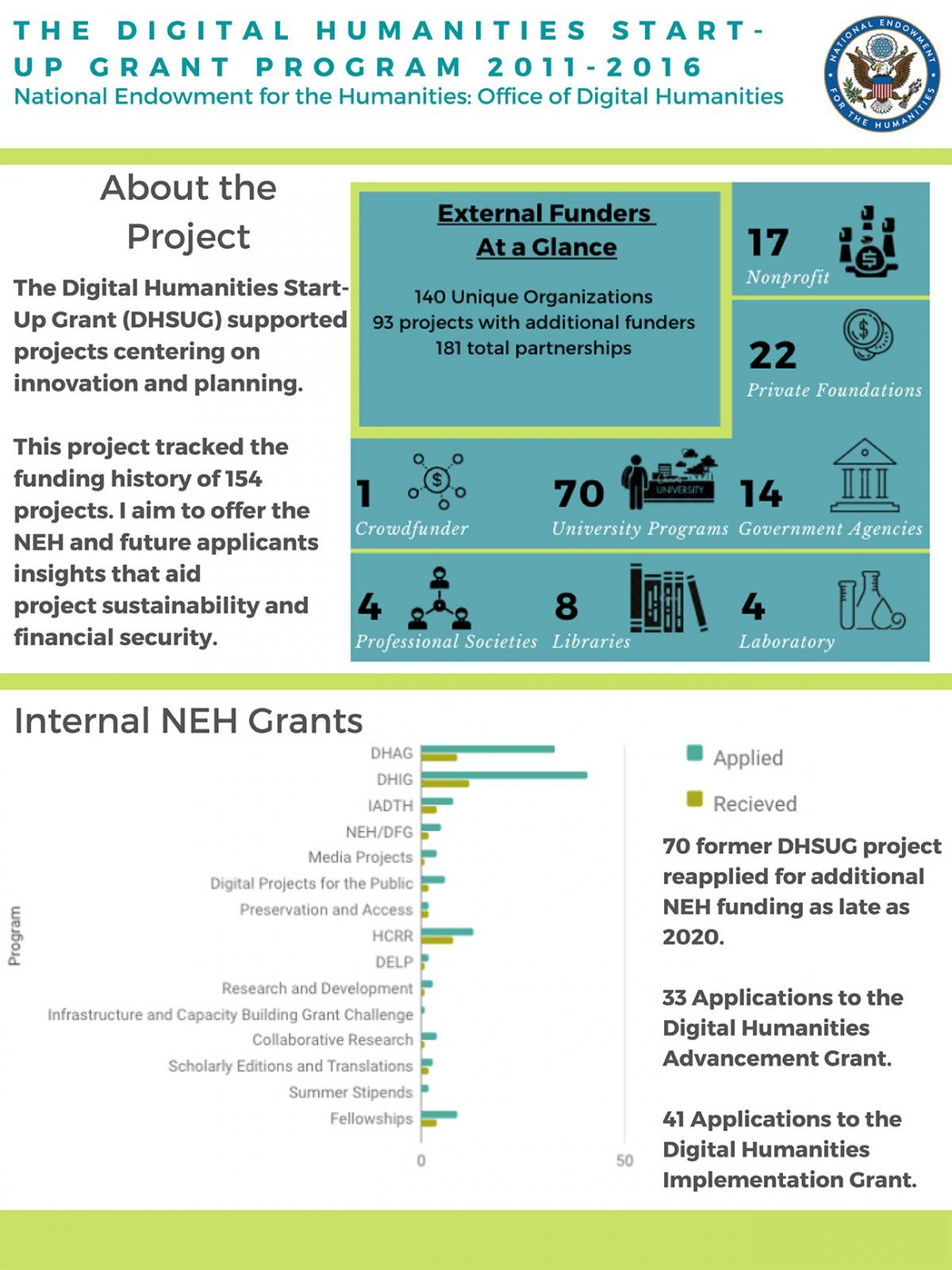The Funding Lifecycles of Digital Humanities Start-Up Grant Projects
This guest blog post was written by Alexandra Sasha Zborovsky, a PhD student in History at the University of Pennsylvania and an intern with the NEH Office of Digital Humanities in the summer of 2020. You can find the complete report in the ODH’s Resource Library.
What happens to innovative digital humanities projects after their initial NEH funding ends?
As a graduate intern for the Office of Digital Humanities (ODH), I completed a project that attempted to answer this question. I conducted this research in my childhood bedroom, over 300 miles from Washington D.C. My goal: to understand how Digital Humanities Start-Up Grant (DHSUG) program awardees funded research beyond the start-up phase, and to provide future projects with funding recommendations that reinforce strong lifecycles.
A Short History
The results of my research require context on the history of grants at the ODH. ODH’s first grant opportunity was the Digital Humanities Start-Up Grant (DHSUG) program that began funding projects in 2007, one of the few federal grant programs encouraging experimental digital work in the humanities. Within a few years, in response to growing need for longer-term funding for digital humanities projects, the ODH launched the Digital Humanities Implementation Grants program (DHIG) in 2011. Applications for the start-up grants were due at one deadline and implementation at another. The ODH then combined these programs in 2016 to form the current multi-level program: the Digital Humanities Advancement Grant (DHAG) program.
Today, the DHAG award supports digital projects as they move through multiple stages of innovation, implementation, and sustainable design. It addresses the needs of short-term experiments and ongoing digital projects, providing potential for a continuous funding relationship with the ODH.
Sources of Funding
As I familiarized myself with the Start-Up Grant projects, I realized that after completing their initial stage, projects obtained additional funding from two main sources: the NEH and other funders and partnerships (such as applicant institutions or private foundations).
After combing through more than one hundred project websites and white papers, I counted that between 2011 and 2016, 101 DHSUG projects received funding from over 140 unique organizations including universities, libraries, laboratories, non-profits, private foundations, crowdfunding efforts, and professional societies. Please refer to the full report for a complete list of external funders.
Within the NEH, 70 former DHSUG projects (69% of DHSUG awardees) reapplied for additional NEH funding as late as 2020, in ODH and other NEH divisions and offices. Though the DHIGs and DHAGs were the most popular grant programs for applicants, many also applied for and received awards overseen by the Division of Preservation and Access and Division of Research.
Building Stronger Funding Lifecycles
While the status of funding neither guarantees nor prevents the success of a project, funding eases costs associated with employing humanities scholars or software engineers, and pays for web domains and data storage. I contacted sixteen DHSUG project directors to learn more about their experiences finding additional funding for their projects. After eight phone/email interviews and additional research, I learned three tactics that projects can use to build on their financial foundation.
I advise both former Start-Up grant and other ODH awardees to reconnect with the NEH Office of Digital Humanities. Four of the interviewed project directors took advantage of renewed contact with the ODH and expressed serious interest in reapplying for NEH funding. They found that the ODH consistently answers questions on the grant application process and even offers to read proposal drafts and provide feedback prior to submission.
When seeking external funding for a DH project, applicants should cast a wide and interdisciplinary net for potential opportunities. Funding for digital humanities projects can even breach the seemingly impenetrable divide between the sciences and humanities. Among the Start-Up Grant projects that I surveyed, the most common source of external funding was the National Science Foundation.
Digital humanities project directors should also seeks grants beyond major national funders, and inquire with local companies and state humanities councils. Projects can receive both research grants from large companies, such as Google or Amazon, and small donations from local companies seeking to boost business by associating themselves with NEH awardees. The latter partnership is evident in the collaboration between the 2013 project, Digital Prosopography for Renaissance Musicians, and regional company Miner & Kasch. A project and a local funder can mutually benefit one another.
Future Research
This research project, though informative, leaves many questions unanswered. While my work provides insights and advice on funding, a project’s academic and technological influence can also affect its lifecycle. Widely cited projects can attract interested investors and a project using outdated technology can sink into the depths of the World Wide Web. Research on these trends can provide supplementary sustainability advice for projects traversing the realm of the digital humanities. Investigating these phenomena, however, remains a potential job for the ODH’s next intern.
